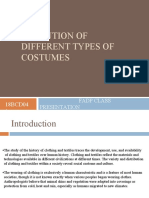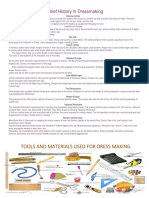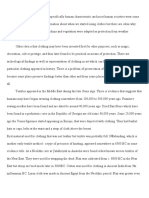0 ratings0% found this document useful (0 votes)
100 viewsThe History of Clothing.: by Șerban Georgia Rafaela
The History of Clothing.: by Șerban Georgia Rafaela
Uploaded by
Rafaela GeorgiaThe history of clothing spans over 100,000 years as humans began wearing animal skins and furs for protection. Early garments were often draped or tied until simple sewing needles provided evidence of sewn leather 30,000 years ago. Ancient civilizations like Mesopotamia, Egypt, and Persia influenced fashion through rich fabrics, embroidery, and stylistic motifs. Through the Middle Ages, Romans adopted barbarian pants and tunics while the Moors introduced patterns to Spain. The Renaissance saw a focus on Italian fashion with feathered hats and heels for women. The 1920s brought a revolution as dresses shortened and the flapper style emphasized comfort over accentuating the figure. By the 1960s-70s
Copyright:
© All Rights Reserved
Available Formats
Download as PPT, PDF, TXT or read online from Scribd
The History of Clothing.: by Șerban Georgia Rafaela
The History of Clothing.: by Șerban Georgia Rafaela
Uploaded by
Rafaela Georgia0 ratings0% found this document useful (0 votes)
100 views22 pagesThe history of clothing spans over 100,000 years as humans began wearing animal skins and furs for protection. Early garments were often draped or tied until simple sewing needles provided evidence of sewn leather 30,000 years ago. Ancient civilizations like Mesopotamia, Egypt, and Persia influenced fashion through rich fabrics, embroidery, and stylistic motifs. Through the Middle Ages, Romans adopted barbarian pants and tunics while the Moors introduced patterns to Spain. The Renaissance saw a focus on Italian fashion with feathered hats and heels for women. The 1920s brought a revolution as dresses shortened and the flapper style emphasized comfort over accentuating the figure. By the 1960s-70s
Original Title
The history of clothingg
Copyright
© © All Rights Reserved
Available Formats
PPT, PDF, TXT or read online from Scribd
Share this document
Did you find this document useful?
Is this content inappropriate?
The history of clothing spans over 100,000 years as humans began wearing animal skins and furs for protection. Early garments were often draped or tied until simple sewing needles provided evidence of sewn leather 30,000 years ago. Ancient civilizations like Mesopotamia, Egypt, and Persia influenced fashion through rich fabrics, embroidery, and stylistic motifs. Through the Middle Ages, Romans adopted barbarian pants and tunics while the Moors introduced patterns to Spain. The Renaissance saw a focus on Italian fashion with feathered hats and heels for women. The 1920s brought a revolution as dresses shortened and the flapper style emphasized comfort over accentuating the figure. By the 1960s-70s
Copyright:
© All Rights Reserved
Available Formats
Download as PPT, PDF, TXT or read online from Scribd
Download as ppt, pdf, or txt
0 ratings0% found this document useful (0 votes)
100 views22 pagesThe History of Clothing.: by Șerban Georgia Rafaela
The History of Clothing.: by Șerban Georgia Rafaela
Uploaded by
Rafaela GeorgiaThe history of clothing spans over 100,000 years as humans began wearing animal skins and furs for protection. Early garments were often draped or tied until simple sewing needles provided evidence of sewn leather 30,000 years ago. Ancient civilizations like Mesopotamia, Egypt, and Persia influenced fashion through rich fabrics, embroidery, and stylistic motifs. Through the Middle Ages, Romans adopted barbarian pants and tunics while the Moors introduced patterns to Spain. The Renaissance saw a focus on Italian fashion with feathered hats and heels for women. The 1920s brought a revolution as dresses shortened and the flapper style emphasized comfort over accentuating the figure. By the 1960s-70s
Copyright:
© All Rights Reserved
Available Formats
Download as PPT, PDF, TXT or read online from Scribd
Download as ppt, pdf, or txt
You are on page 1of 22
The history of clothing.
By Șerban Georgia Rafaela
XI B
Introduction
• It is not certain when people first started wearing
• clothes, however,anthropologists estimate that it
• was somewhere between 100,000 and 500,000 years
• ago. The first clothes were made from natural
• elements:animal skin, fur, grass, leaves, bone, and
• shells.Garments were often draped or tied; however,
• simple needles made out of animal bone provide
• evidence of sewn leather and fur garments from
• at least 30,000 years ago. Hand and hand with the
• history of clothing goes the history of textiles.
• Humans had to invent weaving, spinning, tools, and
• the other techniques needed to be able to make the
• fabrics used for clothing. People wear clothes for many reasons, primarily for
protection and decoration. Garments have been worn for thousands of years as
gender identification, to promote sexual attractiveness, to display status, age,
occupation, religion, group membership, and political affiliation, for ceremonial
occasions, and for personal expression. Primitive cultures of the modern world who
live in clothing optional societies adorn themselves with scarring, tattoos, body paint,
amulets, and headgear.
Fashion history - Mesopotamia
• Located between the Euphrates and Tigris rivers, was, along with
Egypt, a hotbed of civilization whose hegemony lasted until the first
millennium. The clothing of Syria and Persia influences each other.
As a constant design, we have rich fabric embroidery. Persia: The
sixth century BC, the Persian city on the plateau of Iran, was
characterized by ferocity in the struggle of the warrior population par
excellence. The sources for the study of the Persian costume are
the ruins of the ancient city of Persepolis, where the palace of Cyrus
the Great is located. Persian ornamental motifs: animals fighting
with each other, birds, rams, assault towers and fantastic animals. It
should be noted that Persian embroidery is framed in circles or
rectangles.
Mesopotamia
Fashion history - Ancient Egypt
• The poorer classes simply dressed, with few elements such as
shoes, we can see differences in material, in terms of the social
hierarchy of those who use it. The upper class costume of Pharaoh
and his court was called kalasyris. (long tunic, extremely thin
pleated, transparent, decorated with gold and precious stones, such
as turquoise, lapis lazuli, coral, gold, ebony and turtle shells).
Loriga, is a suit worn by women, close to the body, made with a
fiber fabric similar to mesh. Basic unisex shoes: People walked
barefoot, however, they wore papyrus fiber sandals. These were
very light, compared to the suit which was very simple. Clothing and
hairstyles: because of the heat and as a measure of personal
hygiene, men and women shaved their heads and the hair on their
bodies was removed. The upper class imposed the use of various
wigs and ornaments.
Ancient Egypt
fashion
Fashion history - the Middle Ages
• The fashion design of the Middle Ages is still led by the Romans,
although they adopted clothes and styles of barbarians, Byzantines
and Arabs. With the exception of official documents, Romanians
stopped using the toga, influenced by the modesty of the Christian
faith. The design trend was to cover the body. One of the first
adoptions was the use of panties (not modern ones, but a kind of
shorts) that barbarians used. Leggings, leather socks in different
colors were also adopted. The tunic was still used, but wider. The
Arabs wore zaragüelles (wide pants), turbans and hats. Moorish
design patterns were common in Spain, the use of small turbans
and cisterns, a short tunic with tweezers on the arm and waist, but
wide on the rest of the body. At this time, design and fashion
workshops were innovating various items of clothing. These include
leggings and tunics, which have gained great popularity. Although
the biggest novelty was, without a doubt, the skirt that came from
Italy.
The Middle Ages fashion
Fashion history - 12th century
• Fashion history - 12th century During this period, men
wore panties and stockings. The tunic is short, reaching
the knees with long sleeves. The tunics have openings to
remove the arms or sleeves. The hairstyle has some
similarities with the last century, men wearing short hair.
The hat changes depending on the social category. For
women, the tunics were made of fine fabrics, with narrow
sleeves that open at the top of the arm until they reach
the ground. The hair is divided in the center with long
ribbons on the chest; in the tail adorned with ribbons or
curls. The fashion of the modern era is characterized by
great changes from beginning to end. The renaissance
was the splendor of Italian fashion with feather hats and
heeled shoes. Women continue to wear corsets, skirts
and pants.
12th
Century
fashion
Renaissance fashion
• Perhaps the most important change was the struggle of women
against political and social restrictions, which was undoubtedly
manifested in women's relationship with fashion. Thus, in the first
years of the twentieth century the natural figure of the woman
returned, showing her legs. Mini skirts, unisex fashion and pants
appear. Skirts are shortened, mini skirts appear, and unisex fashion
appears, women can wear pants. By the middle of the century,
fashion leadership had moved to the United States. This imposed a
type of fashion for youth and sports, exemplified by the
popularization of jeans. In this century, the manufacture of chain
clothing, with different sizes, appeared, and personalized clothing
decreased dramatically. This made fashion affordable, the
difference between social classes being more in the type of fabric
than in the designed design. Since then, they have been considered
a fad. Lately, the close relationship between the clothing industry
and advertising, has turned fashion into one of the most important
industries in the world. Thus, it reached sales figures that were not
imagined at the beginning of fashion.
Renaissance fashion
1920s fashion
• The 1920s were a great evolution for women, as they
were given the right to vote. Women were no longer
seen as objects, but as individuals. The political
revolution has also led to a fashion revolution. The
dresses were much shorter, and the "flapper" look was a
favorite of women at the time, because it did not
accentuate the figure and was very comfortable. Fashion
developed at a frantic pace in the twentieth century, in
the contemporary era. Some believe that fashion began
in 1900 with the so-called S silhouette, a kind of
"miracle" that pushed the breasts up. Going through lace
and Belle Epoque, we will reach a more comfortable
fashion period for women in the '20s.
20s
fashion
1930s fashion
• In the 1930s, French fashion designer Coco
Chanel reinvented the way women dress, adding
an item of clothing to her wardrobe, which until
now was exclusively for men - pants. Also during
this period, panties were popularized and jackets
became popular. In the 1940s, Christian Dior
adopted a more elegant look, with several
dresses tight around the waist. Female shapes
have been associated with an ideal of beauty
with actresses like Marilyn Monroe as
references.
30s fashion
Fashion in the '60s and' 70s
• The 1970s were known for the Hippie
movement, which was also represented by
clothes. The most popular fashion at the
moment are high-waisted and flared pants. The
clothes were made of comfortable, shiny and
colorful materials. Heeled shoes and
accessories such as bags that were worn with
floral prints began to prevail. In the 1960s, flared
pants and cotton blouses appeared. In the
1970s, floral themes that blended with "retro
fashion" were maintained, and boots triumphed
among women.
60s and 70s fashion
Fashion in the '80s and' 90s
• In the '80s and' 90s, he continued in a line of freedom of
expression and comfort with the novelty of transparency
in clothes. Underwear is no longer a taboo and it is
common for bra straps to be visible, allowing women to
look the way they want. More and more outfits are
associated with social groups and message T-shirts.
Also, hair dye, piercings and tattoos are popular.
80s and 90s
fashion
Fashion history - The 2000s
• Starting with the 21st
• century, in the year
• 2000, there is talk
• about urban tribes and
• a series of brands and
• styles that are associated
• with each of these "tribes".
• Classic suits and dresses
• are worn only on special
• Occasions and to work in
• exclusive environments or for
• the client. The trend of
• personalizing clothes is born. Many
• people create their own clothing and
• accessories, and design and customization options are included in
production processes around the world.
The Evolution.
You might also like
- Umberto Eco History of BeautyDocument435 pagesUmberto Eco History of BeautyEcaterina Guzenco97% (60)
- Psychology Sem-5 E-Txt Book - CompressedDocument155 pagesPsychology Sem-5 E-Txt Book - CompressedUchit MehtaNo ratings yet
- Historic CostumesDocument140 pagesHistoric CostumesDivya Manivannan100% (2)
- Fashion PortFolioDocument62 pagesFashion PortFoliokerry100% (1)
- History of Fashion Through The DecadesDocument73 pagesHistory of Fashion Through The Decadesabhishek_sinha87% (15)
- Project On Trend Analysis On Fashion WearDocument54 pagesProject On Trend Analysis On Fashion Wearvittamsetty88% (8)
- Lesson Plan Bookbinding AccordionDocument6 pagesLesson Plan Bookbinding Accordionapi-532786540No ratings yet
- Hans Belting - The End of The History of Art (1982)Document126 pagesHans Belting - The End of The History of Art (1982)Ross Wolfe100% (7)
- Ranciere - Is There A Deleuzian AestheticsDocument14 pagesRanciere - Is There A Deleuzian AestheticsDennis Schep100% (1)
- The History of ClothingDocument25 pagesThe History of ClothingRafaela GeorgiaNo ratings yet
- EnglishDocument14 pagesEnglishShrey SinghNo ratings yet
- Class 1Document11 pagesClass 1pal dNo ratings yet
- Fashion Through TimeDocument16 pagesFashion Through Timelaur81No ratings yet
- History of CostumesDocument128 pagesHistory of CostumesdhanafdNo ratings yet
- History SummaryDocument4 pagesHistory Summaryapi-378408622No ratings yet
- Advance Textile StudiesDocument7 pagesAdvance Textile StudiesalinaNo ratings yet
- DocumentoDocument5 pagesDocumentoAlessandra VillacortaNo ratings yet
- History of FashionDocument5 pagesHistory of FashionPranjali JoshiNo ratings yet
- Speech The Fashion of Yesterday and TodayDocument7 pagesSpeech The Fashion of Yesterday and TodayScribdTranslationsNo ratings yet
- A Brief History in DressmakingDocument1 pageA Brief History in Dressmakingdouglas.sembranoNo ratings yet
- New Fashion HistoryDocument14 pagesNew Fashion HistoryAkshara AkileshwarNo ratings yet
- English Project DraftDocument11 pagesEnglish Project Draftnitya trivediNo ratings yet
- Historical JournalDocument11 pagesHistorical Journalapi-444873118No ratings yet
- Article 4Document2 pagesArticle 4Hiba SiddiquiNo ratings yet
- Fashion Through TimeDocument3 pagesFashion Through TimeLeontina VlaicuNo ratings yet
- YANGCO ResearchDocument11 pagesYANGCO ResearchPatricia YangcoNo ratings yet
- Evolution of Different Types of Costumes: Fadp Class PresentationDocument11 pagesEvolution of Different Types of Costumes: Fadp Class PresentationSwarnaNo ratings yet
- Trend Timeline of Fashion Ix-XxDocument9 pagesTrend Timeline of Fashion Ix-XxMireyLopezNo ratings yet
- Lucrare Pentru Obţinerea Atestatului de Competenţă Lingvistică Limba Engleză - BilingvDocument13 pagesLucrare Pentru Obţinerea Atestatului de Competenţă Lingvistică Limba Engleză - BilingvIulia Maria Popa100% (1)
- HistoryDocument47 pagesHistoryRAMON ENRIQUEZ HIGH SCHOOLNo ratings yet
- A Brief History in DressmakingDocument2 pagesA Brief History in DressmakingEka MagsigayNo ratings yet
- The Eighteenth Century PDFDocument65 pagesThe Eighteenth Century PDFAlexei Ada100% (2)
- History of CostumeDocument1 pageHistory of Costumekohibat180No ratings yet
- History of Clothing PDFDocument3 pagesHistory of Clothing PDFLizeth Esmeralda Salinas Solis100% (1)
- American RunwayDocument26 pagesAmerican RunwayGayathri SuriyaNo ratings yet
- History of FashionDocument12 pagesHistory of Fashionsaranya saranNo ratings yet
- The History of FashionDocument12 pagesThe History of FashionpinasafNo ratings yet
- WCT Uint 3 B) ENGLANDDocument15 pagesWCT Uint 3 B) ENGLANDakshyakannan26No ratings yet
- The History of 20 Century Women's Clothing: Fashion ForwardDocument10 pagesThe History of 20 Century Women's Clothing: Fashion ForwardMonika KanzzNo ratings yet
- A09 - Various Timelines of Fashion HistoryDocument26 pagesA09 - Various Timelines of Fashion HistorysampleuNo ratings yet
- Lec-1 (History of Fashion)Document30 pagesLec-1 (History of Fashion)tamzidsaquib08No ratings yet
- History of ClothingDocument4 pagesHistory of ClothingMCLEAN JOSHUA BERANANo ratings yet
- Fashion: "Fashion Is Like The Ashes Left Behind The Uniquely Shaped Flames of The Fire, The TraceDocument33 pagesFashion: "Fashion Is Like The Ashes Left Behind The Uniquely Shaped Flames of The Fire, The TraceEINSTEIN2DNo ratings yet
- Women Fashion Through The YearsDocument3 pagesWomen Fashion Through The YearsSara Muñoz GilNo ratings yet
- History of Clothing - History of The Wearing of ClothingDocument7 pagesHistory of Clothing - History of The Wearing of ClothingRajesh0% (1)
- Fashion SocietyDocument37 pagesFashion SocietySitiFauziahMaharaniNo ratings yet
- Fashion As CultureDocument40 pagesFashion As CultureapurvanagaNo ratings yet
- Underwear Fashion History Western EuropeDocument26 pagesUnderwear Fashion History Western EuropeAgos Rusiani100% (2)
- FASHIONDocument7 pagesFASHIONAisyah Mada43% (7)
- Reforming Fashion, 1850-1914Document14 pagesReforming Fashion, 1850-1914Rajesh Kumar RamanNo ratings yet
- 9099 History of ClothingDocument5 pages9099 History of ClothingyamaaraaNo ratings yet
- Historic CostumesDocument140 pagesHistoric Costumesslobodan_janicijevic100% (1)
- History of Clothing and Their Major Characteristics and Appopriate ProjectsDocument3 pagesHistory of Clothing and Their Major Characteristics and Appopriate ProjectsMCLEAN JOSHUA BERANANo ratings yet
- History of Fashion PDF PostingDocument129 pagesHistory of Fashion PDF Postingarti singhNo ratings yet
- ATESTAT - Victorian FashionDocument11 pagesATESTAT - Victorian FashionTarian LaiNo ratings yet
- History of FashionDocument1 pageHistory of Fashionkohibat180No ratings yet
- History of LingerieDocument3 pagesHistory of LingerieRemyaNo ratings yet
- The Retro EraDocument10 pagesThe Retro Erasrimahalakshmi.d2007No ratings yet
- F Wor (L) DDocument6 pagesF Wor (L) DMadalina MoiseNo ratings yet
- The Eighteenth Century (History of Costume and Fashion Volume 5)Document64 pagesThe Eighteenth Century (History of Costume and Fashion Volume 5)Andrei Bálint100% (16)
- Useless Knowledge about Fashion: Amazing and bizarre facts about fashion shows, catwalks, models and the culture of fashionFrom EverandUseless Knowledge about Fashion: Amazing and bizarre facts about fashion shows, catwalks, models and the culture of fashionNo ratings yet
- Art Beyond Itself by Néstor García CancliniDocument24 pagesArt Beyond Itself by Néstor García CancliniDuke University Press75% (4)
- Activities About Thesis StatementDocument7 pagesActivities About Thesis Statementpzblktgld100% (2)
- Eng11 FS1718 ReaderDocument154 pagesEng11 FS1718 ReaderHahns Anthony GenatoNo ratings yet
- We Are Also Music LoversDocument16 pagesWe Are Also Music LoversGuro von GermetenNo ratings yet
- LOCAL ARTS - Can Be OpenedDocument16 pagesLOCAL ARTS - Can Be OpenedEdlyn Faye ArmeñaNo ratings yet
- MODULE 1 Lesson 1Document2 pagesMODULE 1 Lesson 1Nica EllyzaNo ratings yet
- MODULE 8 WESTERN ART HISTORY - MEDIEVAL.19th - CENTURYDocument11 pagesMODULE 8 WESTERN ART HISTORY - MEDIEVAL.19th - CENTURY7 1 2 5 1No ratings yet
- Architectural Forms and Philosophical StructuresDocument21 pagesArchitectural Forms and Philosophical StructuresNileena SankarankuttyNo ratings yet
- Module 1 Arts in Daily LivingDocument17 pagesModule 1 Arts in Daily LivingNordelyn Abid TribunaloNo ratings yet
- Le Champ Des Avant-Gardes Verger AnnieDocument42 pagesLe Champ Des Avant-Gardes Verger AnnieMarioTommasoNo ratings yet
- Handout 4TH Grade - Clothes and FashionDocument5 pagesHandout 4TH Grade - Clothes and FashionVeronica OneaNo ratings yet
- Unit Title: Art Around The World Grade Level: 3rd Grade Time Frame: 6 or More Class SessionsDocument27 pagesUnit Title: Art Around The World Grade Level: 3rd Grade Time Frame: 6 or More Class Sessionsapi-279312232No ratings yet
- Beyond Structural Listening PDFDocument346 pagesBeyond Structural Listening PDFАлександр Земцов100% (1)
- Affandi Self Portrait III-Vanessa Singgih Pranoto (10657)Document9 pagesAffandi Self Portrait III-Vanessa Singgih Pranoto (10657)VanessaSinggihPranotoNo ratings yet
- Ernst Grosse - The Beginning of ArtDocument360 pagesErnst Grosse - The Beginning of ArtminisagaNo ratings yet
- Hayden White On Narrative TheoryDocument2 pagesHayden White On Narrative Theorywyddfa100% (1)
- Internationalism: International Style, Architectural Style That Developed in Europe and The UnitedDocument2 pagesInternationalism: International Style, Architectural Style That Developed in Europe and The UnitedVedant HedauNo ratings yet
- Unit Iii Arts and Crafts MovementDocument12 pagesUnit Iii Arts and Crafts MovementManoj KumarNo ratings yet
- Planning 2-Module 1 Part 2Document22 pagesPlanning 2-Module 1 Part 2Abegail LaronNo ratings yet
- Welcome To All The Pleasures The Politic PDFDocument219 pagesWelcome To All The Pleasures The Politic PDFMargot Muñoz-rubioNo ratings yet
- Interior Architecture NotesDocument3 pagesInterior Architecture NotesMaureen AlboresNo ratings yet
- Contemporary Philippine Art From The RegionsDocument3 pagesContemporary Philippine Art From The RegionsJovie Mae PongtachonNo ratings yet
- Sophie Boyd-Hurrell - The Speculative Ear - Explorations in Adorno and Musical ModernismDocument305 pagesSophie Boyd-Hurrell - The Speculative Ear - Explorations in Adorno and Musical ModernismMandel CabreraNo ratings yet
- List Tempat Magang Terus Diupdate No Studio Target Link Website, Ig, Youtube, FB DSTDocument6 pagesList Tempat Magang Terus Diupdate No Studio Target Link Website, Ig, Youtube, FB DSTAyasha No HayateNo ratings yet
- Regional Environmental Governance: Interdisciplinary Perspectives, Theoretical Issues, Comparative Designs (Regov)Document10 pagesRegional Environmental Governance: Interdisciplinary Perspectives, Theoretical Issues, Comparative Designs (Regov)Felipe PiresNo ratings yet

























































































